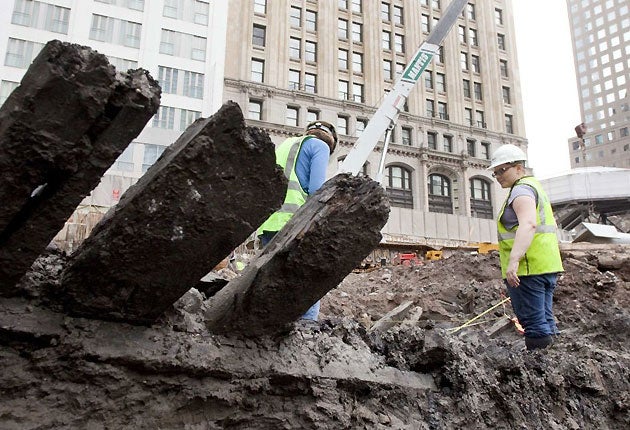Ground Zero builders uncover centuries-old hull

Your support helps us to tell the story
From reproductive rights to climate change to Big Tech, The Independent is on the ground when the story is developing. Whether it's investigating the financials of Elon Musk's pro-Trump PAC or producing our latest documentary, 'The A Word', which shines a light on the American women fighting for reproductive rights, we know how important it is to parse out the facts from the messaging.
At such a critical moment in US history, we need reporters on the ground. Your donation allows us to keep sending journalists to speak to both sides of the story.
The Independent is trusted by Americans across the entire political spectrum. And unlike many other quality news outlets, we choose not to lock Americans out of our reporting and analysis with paywalls. We believe quality journalism should be available to everyone, paid for by those who can afford it.
Your support makes all the difference.Archaeologists at Ground Zero in lower Manhattan are racing to dig out what appears to be remains of the wooden hull of a stubby 18th century ship that construction crews stumbled upon earlier this week as they prepared foundations for the new World Trade Centre complex.
It has been almost 30 years since such a significant remnant of New York’s ocean-going past has been found beneath its pavements. As work continues unabated at the site, archeologists with a firm already hired to document finds of interest there, spearheaded efforts for the hull’s removal to safe ground and more detailed analysis.
“We noticed curved timbers that a back hoe brought up,” Molly McDonald of the company, AKRF, said. “We quickly found the rib of a vessel and continued to clear it away and expose the hull over the last two days.”
The section measures about 32 feet long and may have been dumped along with other landfill to expand the lower end of Manhattan into what used to be the waters of the Hudson River. In a stroke of luck for the archeologists, the weather in New York since Tuesday has been damp. Had the hull’s ribs been exposed to bright sun they might have started to decompose immediately.
A large anchor has also been uncovered, but it’s not clear if belongs to the ship. Digging through layers of mud and oyster shell, they have also found a semi circular steel collar on a brick base that may have been inside the vessel as some kind of oven or primitive steam boiler.
The miracle maybe less that the boat remains were down there but that they survived the scoops of the construction machinery. “I kept thinking of how closely it came to being destroyed,” said Michael Pappalardo also of AKRF. Of seeing the ribs for the first time, he said: “They were so perfectly contoured that they were clearly part of a ship.”
Join our commenting forum
Join thought-provoking conversations, follow other Independent readers and see their replies
Comments